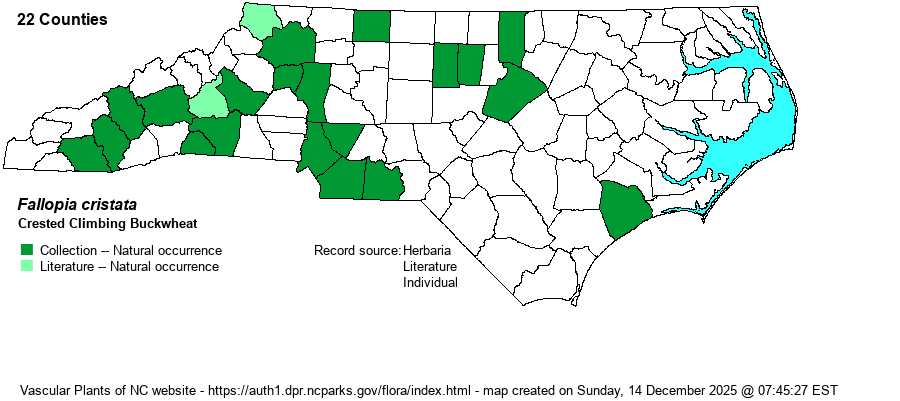| Author | (Engelmann ex A. Gray) Holub | |
| Distribution | Weakley (2023) has moved this taxon back into P. scandens, as many other references have done. Low Mountains and Piedmont; disjunct to the outer Coastal Plain in Onslow County. The maps of this species and F. scandens are drawn from so-named specimens at SERNEC and from maps in RAB (1968). There may well be occurrences in other counties. However, the Digital Atlas of the Virginia Flora website seems conservative, and shows records only from the mountains and northwestern Piedmont. Weakley (2018) does not provide a map, owing to confusion of specimens. Thus, the website editors have no confidence in this map, and whether this "species" is over-reported in NC, or under-reported in VA, for example.
MA to IN and MN, south to central FL and TX. | |
| Abundance | Rare to uncommon in the Mountains and Piedmont, and very rare in the outer Coastal Plain. Based on collections or reports (correct?) from at least 21 counties, the suggested State Rank is S3?; it is already on the NCNHP's Watch List. | |
| Habitat | Mesic to moist soils of lightly wooded slopes, forest openings, maritime forest clearings, stream margins, roadsides. This listing of habitats is quite broad, and perhaps this taxon is more limited in habitat choices. | |
| Phenology | Flowering and fruiting July-October. | |
| Identification | Crested Climbing Buckwheat is one of 3 native species of climbing buckwheats (genus Fallopia). All 3 are very distinctive in their twining, slender stems that bear rather triangular, cordate-based leaves. Fringed Climbing Buckwheat (F. cilinodis) differs from our other two by its bright white petals and its fringe of hairs on the ocreae (short collars at the junction of the main plant stem and leaf stem) vs. pale greenish or creamy yellowish petals and smooth ocreae; it occurs only at high elevations. Common Climbing Buckwheat (F. scandens) has longer petals (10-15 mm long vs. 7-10 mm in cristata) and achenes (3.5-6 mm vs. 2.3.5 mm). The alien F. baldschuanica is woody-based, high-climbing, and freely branched. As mentioned above, this taxon is poorly differentiated from F. scandens, and field observers probably will not be able to separate these two without measuring the flowers and achenes; it is not reported if there are leaf, stem, or other vegetative characters that can separate them. | |
| Taxonomic Comments | Treated by some authors as a variety of F. scandens, as in RAB (1968), or lumped as in FNA. Weakley (2023) also has lumped cristata into scandens. Note that most references have these taxa in the very large genus Polygonum --which clearly needs or needed to be split out into additional genera.
| |
| Other Common Name(s) | Crested Bindweed. The website follows Weakley (2018) with using "Climbing Buckwheat" as the collective group common name. | |
| State Rank | SYN | |
| Global Rank | GNR [G5] | |
| State Status | | |
| US Status | | |
| USACE-agcp | | |
| USACE-emp | | |

